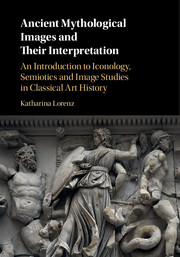 Ancient Mythological Images and their Interpretation
Ancient Mythological Images and their Interpretation 5 - Semiotics in action
from SEMIOTICS
Published online by Cambridge University Press: 05 August 2016
Summary
The semiotic interpretations here are devised as a three-step process, applying structuralist and post-structuralist elements of semiotic enquiry. At the stage of semantics, the focus is on the relationship of the signs and the things to which they refer, the denotations. At the stage of syntactics, the relationships existing between the signs are under scrutiny, that is, the paradigmatic and syntagmatic aspects of the depictions. The stage of pragmatics, finally, sees the exploration of the relationship between the signs shaping the depiction and those people that make sense of these signs.
The Karlsruhe hydria: thresholds of desire, choice, and crisis
Semantics.
Externally, the vase shape and stylistic rendering of the Karlsruhe hydria provide a framework for its use and date. Internally, the two sections of the hydria, the upper picture field and the frieze below, present distinct practices of semiosis: while almost all figures in the upper picture field bear a name label – an index internal to the representation, but external to the figure – those in the frieze below do not. A second gradation sees some figures identified through their attributes as mythological or divine characters, while others lack such defining features or, rather, display features firmly anchored in contemporary life outside the picture, raising questions about their status both in the scene and in relation to the viewer.
One figure's semantic dressing demonstrates such dichotomies to the full. Eris, the personification of strife, is positioned in the central apex of the upper picture field (fig. 5.1). Her label, ERIS, points to the divinity who in counsel with Zeus initiated the Trojan War. And yet, her visual appearance separates her from the gods depicted on the vessel, for whilst the divinities in the scene – Zeus, Hermes, Hera, and Aphrodite – are distinguished by wreaths or fillets in their hair and staffs in their hands, Eris in her thin chiton is displayed as similar to the Eutychia personifications in the picture field, which fits with the fact that her name identifies a divinity whilst also conveying the qualities of Eris as the personification of strife. More importantly, however, Eris resembles the dancing maenads in the lower frieze, and that similarity is stronger than for any of the other figures in the upper picture field, not only in terms of dress but also in light of their shared wild and flowing hairstyles (fig. 5.2).
- Type
- Chapter
- Information
- Ancient Mythological Images and their InterpretationAn Introduction to Iconology, Semiotics and Image Studies in Classical Art History, pp. 118 - 151Publisher: Cambridge University PressPrint publication year: 2016
